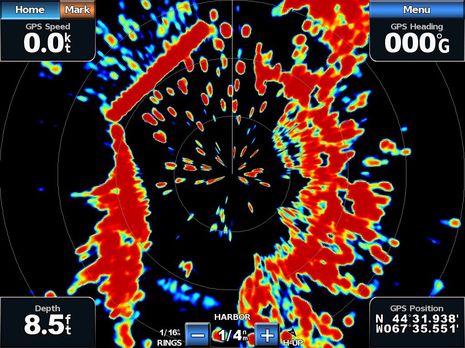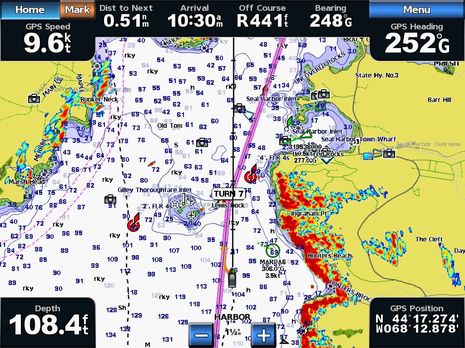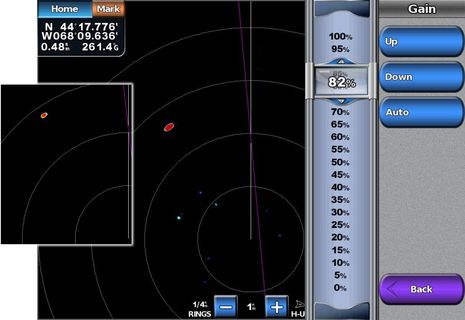Garmin GMR 604 xHD, hand's on

So that's the Garmin GMR 604 xHD open array radar I installed last May painting a crowded harbor on the screen of a GPSMap 7212 in late July. Gizmo was headed southwest at the time -- the GPS heading, or COG, is meaningless because she's tied up to a float -- and so you have to twist your brain a bit to see how well the radar is imaging the details of Jonesport's Sawyer Cove, and hence that the long straight target at the upper left is the famously uncharted steel and concrete breakwater there. And I think if you make the comparison you'll agree that the true color target display really helps to understand what the radar is doing. Those light blue and green returns at upper left, for instance, are almost certainly some sort of noise created the breakwater's heft and hardness. I could have turned the gain down to eliminate that noise, but then I might not have seen the light blue at lower left -- which is an emerging mud flat, I think -- and similarly difficult targets once I got underway. True color returns is indeed my favorite feature of the xHD/7212 combination...
It's a little sad, in fact, that the xHD radars can't show their colors on Garmin's 4- and 5000 MFDs (there's an example of a similarly dense target scene in monochrome at the bottom of that original 604 xHD entry). Not enough processor horsepower, I guess, though the earlier MFD series can handle xHD dual range mode, which works quite well. That's a valuable feature as longer ranges tend to miss smaller close-in targets, even on these high end digital sets, but personally I'd like to see all the dual range sets able to do chart overlay with at least one of the two ranges. Which is so far only possible with the Furuno DRS radars, I'm pretty sure. I also see value in xHD's high speed mode, though a 4-foot array spinning over your head at 48 rpm is a little distracting (even if it is fairly quiet), and when you really want speed -- like when a fast target appears close in -- it's more useful to have it automatically increased at shorter ranges, as is possible with Furuno and Raymarine sets.I've already written about the neat way Garmin overlays routes and waypoints on the radar screen (if you want) along with the slight irritation that 3D radar overlay is nearly the same color as 3D hazzard depths. But the latter -- and many of my xHD quibbles, I think -- can be fixed in software. My biggest request in that department is the addition of the echo expansion feature that most other radar displays have (though sometimes with a different name). This is probably particularly true with open arrays because the smaller beam width (1.8 degrees in this case) can detail targets better. That's useful in some cases, but not when their overlay versions get lost in the chart display. I distinctly remember taking the screen shot below to illustrate how hard it was to see bouys, a ledge, and MARPA target on this overlay though they were being targeted perfectly well...
At least theoretically I have a set of longer range xHD screens from some comparisons I ran in the fall, though they're eluding me just now. When and if found you probably won't be surprised that the 604's six kilowatts pulses and that narrow beam width are pretty long sighted. My general sense is that the xHD hardware has nearly the overall targeting abilities that Furuno and Raymarine have developed in their high end scanners, but that Garmin still has ways to go with the display and controls. Then again, constant improvement and regular software updates are nearly religious with Garmin. And who will be surprised if xHD technology moves down into Garmin's radomes?



 Share
Share
Ben-
I dont think the weaker returns outside of the breakwater are from waves. They are too discrete and if you look closely you can see copies of targets that are INSIDE the breakwater.
I believe that you are seeing "multiple time around" targets and targets reflected to the radar from the wall and off the water. Look carefully at the wall - its impossible to see through the wall but targets are showiing up immediately beside the outside of the wall. Where is the radar shadow cast by the breakwater on the water on the far side?
You have the gain up so high that the reflections of targets inside the wall that are scatteredback to the water and then to the radar or appear on the second pulse train set - appear as being twice the range they really are and end up projected to the far side of the wall.
The entrance to the bay must also have waves - but none are seen - they only appear on the far side of the wall - suggesting the wall is reflecting target returns from inside the wall back to the radar at longer distances due to the longer time delays. The targets outside the wall are also weaker than those inside the wall - suggesting the power loss of the extra reflections.